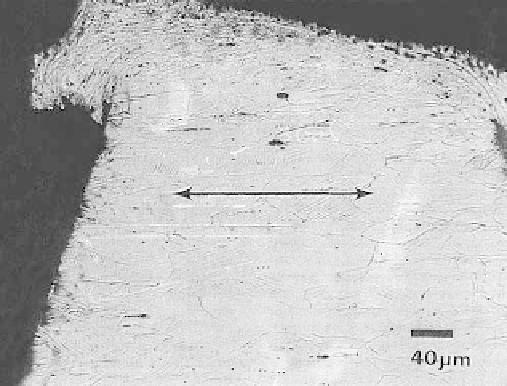Biomedical Engineering Reference
In-Depth Information
Table 3.2.9-2 Typical mechanical properties of implant metals
a
Material
ASTM
designation
Condition
Young's
modulus
(GPa)
Yield
strength
(MPa)
Tensile
strength
(MPa)
Fatigue
endurance limit
(at 10
7
cycles, R
[ L
1
c
)
(MPa)
Stainless steel
F745
Annealed
190
221
483
221-280
F55, F56, F138, F139
Annealed
190
331
586
241-276
30% Cold worked
190
792
930
310-448
Cold forged
190
1213
1351
820
Co-Cr alloys
F75
As-cast/annealed
210
448-517
655-889
207-310
P/M HIP
b
253
841
1277
725-950
F799
Hot forged
210
896-1200
1399-1586
600-896
F90
Annealed
210
448-648
951-1220
Not available
44% Cold worked
210
1606
1896
586
F562
Hot forged
232
965-1000
1206
500
Cold worked, aged
232
1500
1795
689-793 (axial tension
R ¼ 0.05, 30 Hz)
Ti alloys
F67
30% Cold-worked Grade 4
110
485
760
300
F136
Forged annealed
116
896
965
620
Forged, heat treated
116
1034
1103
620-689
a
Data collected from references noted at the end of this section, especially table 1 in
Davidson and Georgette (1986)
.
b
P/M HIP; Powder metallurgy product, hot-isostatically pressed.
c
R is defined as
s
min
/
s
max
.
desired shape (e.g., femoral stems for artificial hips, oral
implants, dental partial bridgework). The sometimes
intricately shaped molds are made by fabricating a wax
pattern to near-final dimensions of the implant and then
coating (or investing) the pattern with a special ceramic,
which then holds its shape after the wax is burned out
prior to castingdhence the ''lost wax'' name of the pro-
cess. Molten metal is poured into the ceramic mold
through sprues, or pathways. Then, once the metal has
solidified into the shape of the mold, the ceramic mold is
cracked away and processing of the metal continues
toward the final device.
Depending on the exact casting details, this process can
produce at least three microstructural features that can
strongly influence implant properties, often negatively.
First, as-cast F75 alloy (
Figs. 3.2.9-6
and
3.2.9-7A
)
typically consists of a Co-rich matrix (alpha phase) plus
interdendritic and grain-boundary carbides (primarily
M
23
C
6
, where M represents Co, Cr, or Mo).
There can also be interdendritic Co and Mo-rich sigma
intermetallic, and Co-based gamma phases. Overall, the
Fig. 3.2.9-5 Evidence of textured grain structure in 316L stainless
steel ASTM F138, as seen in a longitudinal section through a
cold-worked bone screw. The long axis of the screw is indicated
by the arrow.



















































































